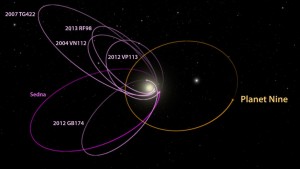Science Seen Physicist and Time One author Colin Gillespie helps you understand your world.
The Search for the Mystery Planet
A new mystery planet is in the astronomic news. It is a real mystery. But is it a real planet?
First the mystery: Planet X, as some are calling it, is thought to roam outside the orbit of Pluto (which was recently demoted to dwarf from ninth-planet status). So far no-one has seen Planet X. So how come some astronomers think it is there?
Science history is replete with instances of new objects discovered, not by observing them, but by observing their effects. Famously, this kind of evidence turned up the planet Uranus. Observed anomalies in Neptune’s orbit were explained by predicting the location of an unknown planet whose gravity must be interfering. Uranus was soon seen where it was expected.
Just so with Planet X. If it exists it is a giant planet with a mass at least ten times that of Earth. It does what other giants such as Jupiter do. With its great gravity it organizes others. But Planet X is much smaller then Jupiter and it roams far reaches of the Solar System in the Kuiper belt, a zone of oversized ice cubes, asteroids, cometary trash and occasional big bodies. These are what it can organize and it is this organizing that reveals its presence.
The details get a little technical. Suffice to say the orbits of too many large objects in the Kuiper belt are too well aligned to make it likely they are random. Two Caltech planetologists have computed an orbit for a large mystery planet that offers a simple explanation for them. And three McGill University planetary scientists recently showed that several existing infrared telescopes should be able to detect this planet if it’s there. Astronomers love finding new planets. Look for more news soon.
well aligned to make it likely they are random. Two Caltech planetologists have computed an orbit for a large mystery planet that offers a simple explanation for them. And three McGill University planetary scientists recently showed that several existing infrared telescopes should be able to detect this planet if it’s there. Astronomers love finding new planets. Look for more news soon.
There’s another story behind this story. It’s no mystery although it does involve a murder. Michael Brown is the senior author of the paper that predicts this planet (and calls it a planet!). This is the same Michael Brown who led the charge to kill off Pluto’s planetary status a decade ago. What was the deficiency that did poor Pluto in? It does meet two of three criteria for planets. It orbits around the Sun. So does Planet X. It is big enough for its own gravity to make it spheroidal. And surely so is ten-times-bigger Planet X. But Pluto does not meet the third criterion: It has not cleared the trash out of its Kuiper-belt neighbourhood. And neither has “Planet X”. Like Pluto it fails the planet test.
It would be a gross injustice if the astronomical community were to install Planet X as the new ninth planet. Though it is at least fifty times more massive than Pluto, this does not qualify it. We must await the next debate before the International Astronomical Union and trust that interplanetary fairness will prevail. Meantime, while searchers close in, it seems likely that the headlines will keep calling it a planet. Until its fate is decided it needs a proper name.
On behalf of millions of fans of Frank Herbert’s fantastic Dune sci-fi novels I would therefore like to make a nomination. Indeed, in Dune-world it already has a name: It’s not X. It’s Ix.
Source:
Constantin Batygin & Michael Brown (2016), “Evidence for a distant giant planet in the Solar system”, Astr. J., vol. 151, p. 22; https://arxiv.org/abs/1601.05438
Nicholas Cowan et al. (2016), “Cosmologists in Search of Planet Nine: The Case for CMB Experiments”, Astr. J. Lett., vol. 822, p. L2.
Other Materials:
International Astronomical Union (2006), Resolution B5; https://www.iau.org/static/resolutions/Resolution_GA26-5-6.pdf
Michael Brown (2010), How I Killed Pluto and Why It Had It Coming, New York: Spiegel & Grau; review at http://web.gps.caltech.edu/~mbrown/howikilled.html
Image credit: Caltech/R. Hurt (IPAC)

No comments yet.